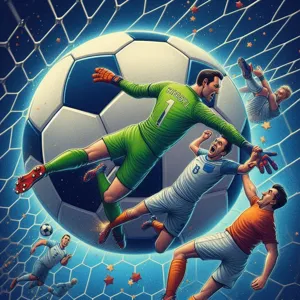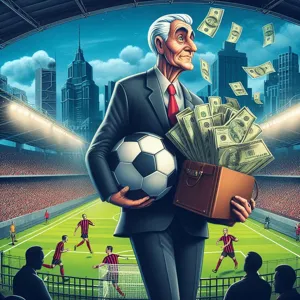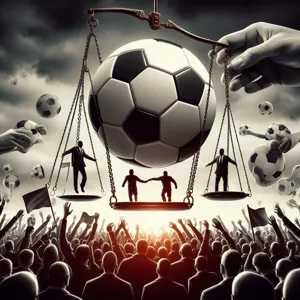In the beautiful game of soccer, the thrill of competition is often overshadowed by the pressing need for fairness and integrity on the field.
As the sport continues to grow globally, so do the challenges of maintaining a level playing field, where every player, regardless of background or skill, has the opportunity to shine. From grassroots initiatives to professional leagues, promoting fair play is essential not only for the spirit of the game but also for fostering respect, inclusivity, and sportsmanship among players and fans alike. In this blog post, we will explore innovative strategies that clubs, coaches, and communities can adopt to champion fair play in soccer. By highlighting impactful programs, collaborative efforts, and the role of education, we aim to inspire a movement that ensures the game remains as much about camaraderie and fairness as it is about skill and competition. Join us as we delve into the importance of leveling the field and how we can all contribute to a more equitable soccer landscape.
1. Introduction to Fair Play in Soccer

Soccer, often referred to as the beautiful game, is more than just a sport; it embodies a global culture, fostering connections among millions of fans and players alike. At the heart of this beloved game lies the principle of fair play, a vital tenet that promotes respect, integrity, and sportsmanship both on and off the field. Fair play in soccer is not just about following the rules; it’s about cultivating an environment where players can thrive, competitors can challenge each other respectfully, and fans can enjoy the game in its purest form.
As we delve into the significance of fair play, it’s essential to understand its multifaceted nature. Fair play encourages positive behavior among players, coaches, and supporters, emphasizing the importance of respecting opponents and officials. It serves as a counterbalance to the intense emotions that often accompany competitive sports, reminding us that the spirit of the game transcends the final score.
Moreover, fair play fosters inclusivity, ensuring that players from all backgrounds have equal opportunities to participate and succeed. By promoting fair play, we can combat issues such as discrimination, violence, and unsportsmanlike conduct that sometimes seep into the sport. This commitment to fairness not only enhances the experience for players but also enriches the overall culture of soccer.
In this blog post, we will explore various strategies and initiatives designed to promote fair play in soccer, highlighting the importance of education, community involvement, and the role of governing bodies. By implementing these practices, we can help ensure that soccer remains a sport that celebrates unity, respect, and fair competition for generations to come. Join us as we embark on this journey to level the playing field and uphold the values that make soccer a cherished pastime around the world.
2. The Importance of Fair Play in Sports
Fair play is the cornerstone of any sport, but its significance in soccer cannot be overstated. At its core, fair play embodies respect, integrity, and sportsmanship—principles that extend far beyond the field. When players, coaches, and spectators embrace these values, they contribute to an environment that nurtures not only athletic excellence but also personal growth and community spirit.
In soccer, where the competition can often be fierce, the importance of fair play becomes even more pronounced. It sets the tone for how the game is played and perceived. Players who engage in fair play not only enhance their own reputations but also elevate the standards of the sport. This commitment to integrity fosters trust among teammates, opponents, referees, and fans alike, creating a more enjoyable and meaningful experience for everyone involved.
Moreover, fair play serves as a powerful educational tool. Young athletes learn that success is not solely measured by wins and losses but also by how they conduct themselves on and off the pitch. By promoting values such as teamwork, respect for officials, and empathy towards opponents, we prepare the next generation not just as athletes, but as responsible citizens.
In today’s hyper-competitive sports culture, instances of cheating, diving, and unsportsmanlike conduct can tarnish the beautiful game. However, organizations at all levels are increasingly recognizing the need to promote fair play through various initiatives, such as educational programs, awards for sportsmanship, and campaigns that highlight the importance of ethical behavior in soccer.
When fair play is prioritized, it enhances the quality of the game and ensures that soccer remains a source of passion, joy, and inspiration for generations to come. As we continue to champion these principles, we cultivate a sport where everyone, regardless of skill level or background, can thrive in an atmosphere of camaraderie and respect.
3. Understanding the Rules: Educating Players and Coaches

Understanding the rules of soccer is paramount to fostering a culture of fair play on the field. Educating players and coaches alike helps to ensure that everyone involved in the game is on the same page, promoting not only skillful play but also respect for opponents and officials. By comprehensively grasping the laws of the game, individuals can make informed decisions during matches and avoid unnecessary conflicts.
Start by organizing workshops or training sessions that delve into the intricacies of the game’s regulations. These sessions should cover essential topics such as fouls, offside rules, and the purpose of various set pieces. Utilizing visual aids, such as videos and diagrams, can enhance understanding, making it easier for participants to visualize scenarios they may encounter during play.
Additionally, incorporating real-life situations into these discussions fosters critical thinking and allows players to apply their knowledge practically. Role-playing exercises can be particularly effective; for instance, simulating game conditions where players must quickly analyze and respond to a foul or an offside call helps them internalize the rules.
Coaches play a crucial role in this educational process. They should lead by example, demonstrating adherence to the rules and instilling a sense of sportsmanship in their teams. Encouraging open dialogue about rule interpretations and the importance of fair play creates an environment where players feel comfortable discussing issues they encounter on the field.
Moreover, consider distributing rulebooks and quick-reference guides to players and their families. This resource not only reinforces learning but also invites ongoing conversations about the game beyond practice and matches. By prioritizing rule education, we cultivate a deeper respect for the game and each other, ultimately promoting an environment where fair play thrives and the spirit of soccer is honored.
4. Implementing Fair Play Policies at Clubs
Implementing fair play policies at soccer clubs is crucial for fostering a culture of respect, integrity, and sportsmanship both on and off the field. These policies serve as a foundational framework that not only guides players’ behavior but also sets expectations for coaches, officials, and fans alike.
To begin with, it’s essential for clubs to establish a clear code of conduct that outlines acceptable behaviors and the consequences for violations. This code should emphasize the values of respect for opponents, adherence to the rules, and the importance of playing hard but fair. Clubs can engage players in the development of these policies, encouraging them to take ownership of the principles of fair play. This involvement fosters a sense of accountability and commitment that can significantly enhance compliance.
Moreover, training sessions and workshops centered on fair play can be incredibly beneficial. These sessions can teach players about the importance of sportsmanship, how to handle conflicts on the pitch, and the significance of respecting referees’ decisions, even when they disagree. Incorporating role-playing scenarios can help players navigate real-life situations they might encounter during matches, reinforcing the lessons learned in a practical context.
In addition, clubs should actively promote fair play through their communication channels. This could include recognizing players who exemplify sportsmanship during games or highlighting positive interactions through social media. Celebrating these moments not only reinforces the behavior within the team but also showcases the club’s commitment to fair play to the broader community.
Lastly, it’s essential for club leadership to lead by example. Coaches and administrators should model fair play behaviors in their interactions with players, opposing teams, and officials. When players see their mentors embodying the principles of sportsmanship, they are more likely to emulate those behaviors themselves.
By implementing comprehensive fair play policies, clubs can create an environment where respect and integrity flourish, ultimately leading to a more enjoyable and equitable experience for everyone involved in the beautiful game.
5. Encouraging Sportsmanship Among Players

Encouraging sportsmanship among players is a cornerstone of cultivating a fair and respectful environment in soccer. Sportsmanship transcends mere adherence to rules; it embodies the spirit of the game, fostering respect for opponents, teammates, officials, and the game itself. By promoting a culture of sportsmanship, we not only enhance the player experience but also contribute to the integrity of the sport.
To instill these values, coaches and organizations can implement a variety of strategies. First and foremost, leading by example is crucial. Coaches should model respectful behavior during practices and games, demonstrating how to handle both victories and defeats gracefully. When players witness their mentors celebrating with humility and accepting losses with dignity, they are more likely to emulate that behavior.
Incorporating sportsmanship education into training sessions can also be beneficial. Workshops and discussions can focus on the importance of fair play, respect for officials, and the value of teamwork. Role-playing scenarios where players must navigate conflicts or challenging situations can help them develop the skills needed to respond positively on the field.
Recognizing and rewarding displays of sportsmanship is another effective strategy. Celebrating players who exhibit kindness, support, and respect—whether through a shout-out during team meetings or sportsmanship awards at the end of the season—reinforces these behaviors and motivates others to follow suit.
Additionally, creating an environment where open communication is encouraged can help address any issues related to unsportsmanlike behavior. Players should feel comfortable discussing concerns about conduct, whether it pertains to themselves, teammates, or opponents. This transparency allows for collective accountability and fosters mutual respect among all participants.
By embedding sportsmanship into the fabric of soccer culture, we can cultivate not just better athletes, but better individuals. When players learn to value fairness and respect, they contribute to a more positive atmosphere on and off the field, ensuring that the beautiful game remains a celebration of skill, teamwork, and integrity.
6. Role of Referees in Promoting Fair Play
Referees play a crucial role in promoting fair play on the soccer field, serving as the backbone of the game’s integrity. Their presence is not merely to enforce the rules, but to embody the spirit of fairness and impartiality that soccer demands. A well-trained referee can significantly influence the dynamics of a match, ensuring that all players adhere to the laws of the game while upholding the principles of respect and sportsmanship.
To effectively promote fair play, referees must be equipped with comprehensive knowledge of the game’s regulations. This involves not only a strong understanding of the rules but also the ability to apply them consistently and fairly. A confident and authoritative referee can command respect from players, coaches, and fans alike, creating an environment where fair play is not just encouraged but expected.
Moreover, referees are tasked with making quick, often high-pressure decisions in real-time. Their judgment calls can be pivotal, determining the outcome of a match and influencing player behavior. By maintaining a calm demeanor and demonstrating clear communication, referees can mitigate tensions on the field and foster a culture of respect among players. When players see that the referee is fair and impartial, they are more likely to emulate that behavior themselves, leading to a more sportsmanlike atmosphere.
Additionally, referees can play an educational role by communicating with players about the importance of fair play. By issuing warnings or engaging in brief discussions with players who may be displaying unsportsmanlike conduct, referees can serve as mentors, guiding players toward more respectful behavior. This proactive approach not only reinforces the rules but also helps cultivate a shared understanding of what it means to play fairly.
In summary, referees are not just enforcers of the game; they are vital champions of fair play. Through their actions, decisions, and communication, they can significantly influence the culture of the sport, encouraging respect and integrity on and off the field. By supporting referees in their role and recognizing their importance in fostering fair play, we can help create a soccer environment that celebrates not just the competition, but the core values that make the game truly beautiful.
7. Engaging Parents and Fans in Fair Play Initiatives

Engaging parents and fans in fair play initiatives is crucial for fostering a culture of respect and integrity within the sport. Soccer is as much about community as it is about competition, and when parents and supporters are actively involved in promoting fair play, the message resonates far beyond the pitch.
One effective strategy is to organize workshops or informational sessions that educate parents and fans about the importance of sportsmanship. These gatherings can cover topics like how to model positive behavior during games, the impact of their reactions on young players, and the value of applauding good plays from both teams. By providing concrete examples and encouraging open discussions, you create an environment where everyone feels empowered to contribute to a positive atmosphere.
Additionally, incorporating fair play initiatives into fan engagement activities can have a lasting impact. For instance, consider creating a “Fair Play Award” that recognizes teams, players, or even fans who exemplify sportsmanship throughout the season. This not only rewards positive behavior but also sets a benchmark for others to aspire to. Featuring these stories in newsletters, on social media, or during game announcements can amplify the message of fair play and inspire others to follow suit.
Moreover, parents and fans can play a significant role in leading by example. Encourage them to cheer for good plays, regardless of the team, and to promote a culture of respect towards referees, coaches, and opposing teams. When parents and fans display positive attitudes, it sets the tone for young athletes, reinforcing the idea that the spirit of the game is just as important as the final score.
Ultimately, when you engage parents and fans in fair play initiatives, you create a supportive community that prioritizes respect, integrity, and enjoyment of the game. By uniting everyone under the banner of fair play, you not only enhance the soccer experience for players but also cultivate a legacy of sportsmanship that will be upheld for generations to come.
8. Developing Fair Play Programs for Youth Leagues
Developing Fair Play Programs for youth leagues is a cornerstone in fostering a culture of respect, integrity, and sportsmanship from an early age. These programs not only teach young athletes the rules of the game but also emphasize the importance of fair play, cooperation, and mutual respect among players, coaches, and referees.
To create an effective Fair Play Program, it’s essential to engage all stakeholders involved in youth soccer—coaches, parents, players, and league administrators. Start by conducting workshops and training sessions that highlight the principles of fair play, illustrating how ethical behavior on and off the field can enhance the overall experience of the game. Use real-life scenarios and role-playing exercises to help participants understand the impact of their actions and decisions during matches.
Incorporating fun and interactive elements can make these programs more appealing to young players. Organizing fair play tournaments where teams are rewarded not just for their victories but also for their sportsmanship can motivate players to adhere to these values. Consider implementing a system of recognition, such as the “Fair Play Award,” which can be presented at the end of the season to teams or individuals who exemplify outstanding conduct.
Furthermore, communication is key. Create newsletters or social media campaigns that highlight fair play successes within the league, showcasing stories of players who have gone above and beyond to support their teammates and opponents alike. By sharing positive narratives, you can cultivate a community that prioritizes integrity and camaraderie, making fair play not just a rule but a shared value that resonates throughout the league.
Involving parents in this initiative is equally important. Host informational sessions that educate them about their role in promoting fair play, encouraging them to model respectful behavior during games and practices. By setting a positive example, parents can reinforce the lessons learned on the field, creating an environment where young athletes feel supported and motivated to uphold the spirit of the game.
Ultimately, developing Fair Play Programs for youth leagues is about more than just compliance with rules—it’s about nurturing a generation of players who understand that the essence of soccer lies in teamwork, respect, and the joy of the game. Through these initiatives, we can ensure that the values of fair play are ingrained in young athletes, shaping them into not only better players but also better individuals.
9. Case Studies: Successful Fair Play Campaigns
In the world of soccer, fair play isn’t just a lofty ideal—it’s a movement that has seen substantial success through various campaigns across the globe. These case studies illustrate how proactive initiatives can foster a culture of respect and integrity on and off the field, ultimately elevating the game itself.
One notable example is the English FA’s “Respect” campaign, launched in 2008. This initiative aimed to promote a culture of respect among players, officials, and fans. By deploying educational resources, workshops, and promotional materials, the FA successfully engaged coaches, players, and schools, culminating in a visible reduction of dissent during matches. The campaign’s impact was profound, as it not only enhanced the behavior of players on the pitch but also cultivated a more positive atmosphere in the stands, where spectators learned to appreciate the spirit of the game rather than just the outcome.
Another compelling case is UEFA’s “Respect Your Referee” campaign, which sought to address the growing issue of referee abuse in youth soccer. By creating engaging videos, infographics, and educational articles, UEFA highlighted the critical role that referees play in maintaining the integrity of the game. The campaign included workshops for coaches and players, emphasizing the importance of sporting behavior and mutual respect. As a result, many football associations reported a notable decline in incidents of referee abuse and an increase in the number of young people willing to take up officiating roles.
A grassroots initiative that has made waves is the “Fair Play Foundation” in Sweden. This organization works closely with local clubs to integrate fair play principles into training sessions and match days. They have developed a “Fair Play Certificate” that clubs can earn by demonstrating their commitment to promoting respect, cooperation, and understanding within teams. This certification has not only motivated clubs to adopt fair play policies but has also fostered community spirit, as parents and fans rally around teams that embody these values.
These case studies serve as powerful reminders that promoting fair play in soccer is not just achievable but essential for the growth of the sport. By learning from these successful campaigns, other organizations and leagues can tailor their strategies to create a more respectful, enjoyable, and inclusive environment for everyone involved in the beautiful game.
10. Utilizing Technology to Enhance Fair Play
In the ever-evolving world of soccer, technology plays a pivotal role in promoting fair play and ensuring that the integrity of the game is upheld. From video assistant referees (VAR) to advanced tracking systems, integrating technology into the beautiful game not only helps in making accurate decisions but also fosters a culture of transparency and accountability among players, coaches, and officials.
One of the most significant advancements is VAR, which allows referees to review critical match incidents using video footage. This technology helps in correcting clear errors related to goals, penalty decisions, and red cards, ensuring that the right calls are made. While VAR has sparked debates about its implementation, its potential to minimize human error is undeniable, making it a crucial tool for fair play.
Moreover, wearable technology, such as GPS trackers and heart rate monitors, is increasingly being adopted by teams to monitor player performance and fitness levels. By analyzing this data, coaches can make informed decisions about player selection and game strategies, promoting a fair competition where athletes are judged based on their skills and fitness rather than external factors.
Additionally, match officials are now equipped with communication tools that allow for real-time discussions and quick consultations, enhancing their ability to enforce the rules consistently. With the help of technology, referees can make decisions that are not only accurate but also impartial, ensuring that the game remains fair for all participants.
By embracing these technological advancements, the soccer community can work towards a future where fair play is not just encouraged but actively enforced. The goal is to create an environment where players can compete on a level playing field, free from the shadow of bias or error—ultimately preserving the spirit of the game for generations to come.
11. Addressing Cheating and Unsportsmanlike Behavior
Addressing cheating and unsportsmanlike behavior is crucial in fostering a culture of integrity and respect within the beautiful game of soccer. Cheating can manifest in various forms, from diving and simulation to intentional fouls and the use of performance-enhancing drugs. Unsportsmanlike behavior, including taunting opponents or disputing every referee decision, undermines the spirit of the game and can create a toxic environment for players and fans alike.
To effectively combat these issues, it’s essential to implement clear and consistent rules that outline the consequences of such actions. Educating coaches, players, and referees about the importance of fair play is paramount. Workshops and seminars can be organized to emphasize the values of sportsmanship, highlighting examples of both positive and negative behavior on the field. Encouraging open discussions about the impact of cheating not only aids in understanding the consequences but also empowers individuals to stand up against it.
Furthermore, technology can play a significant role in promoting fair play. The introduction of video assistant referees (VAR) has already made strides in reducing instances of cheating, ensuring that critical decisions are made accurately. Leveraging technology to review plays and validate calls can deter players from engaging in dishonest tactics, as they will be aware that their actions are under scrutiny.
Community engagement is also vital. By involving parents, local clubs, and fans in conversations about the importance of fair play, we can cultivate a more supportive environment. Celebrating instances of sportsmanship—whether through awards, recognition in local media, or social media shout-outs—can help shift the focus from merely winning to playing the game with honor.
Ultimately, addressing cheating and unsportsmanlike behavior requires a collective effort from everyone involved in the sport. By instilling a sense of accountability and fostering an environment that values respect and integrity, we can ensure that soccer remains a true reflection of teamwork, skill, and fair competition.
12. The Role of Media in Promoting Fair Play
The media plays a pivotal role in shaping perceptions and promoting fair play in soccer, serving as both a mirror and a beacon for the sport. With the power to reach millions, media outlets have the unique ability to highlight stories of integrity, sportsmanship, and respect on and off the pitch. By showcasing positive examples of athletes who demonstrate fair play, the media can inspire a culture of sportsmanship that resonates with fans, players, and aspiring athletes alike.
Coverage of matches should not solely focus on the final score or controversial moments; instead, it can delve deeper into narratives that emphasize the importance of fair conduct. Features on players who prioritize respect and cooperation, or profiles of teams that exemplify teamwork and ethical competition can shift the conversation from solely winning to the values that underpin the beautiful game.
Moreover, social media is an invaluable tool that can amplify these messages. By sharing highlights of good sportsmanship, celebrating players who stand up against unfair play, and engaging with fans in discussions about the importance of integrity, platforms like Twitter, Instagram, and TikTok can create a community that values fair play.
Additionally, the media can hold players and clubs accountable for their actions. When misconduct occurs, it is essential that these incidents are reported responsibly, emphasizing the repercussions and encouraging a dialogue about the need for fair play. By doing so, the media not only informs the public but also reinforces the idea that fair play is a fundamental aspect of the sport.
In essence, the media’s role is twofold: to celebrate and elevate the ideals of fair play while also serving as a watchdog that holds the soccer community accountable. By leveraging their platforms effectively, media organizations can contribute significantly to a culture of respect, ensuring that fair play remains at the heart of soccer for generations to come.
13. Collaborating with Organizations for Fair Play Advocacy
Collaboration is a powerful tool in the quest for fairness on the soccer field. By partnering with organizations dedicated to promoting fair play, leagues, clubs, and players can amplify their message and create a more significant impact within the community. These organizations often have established networks, resources, and expertise that can enhance your efforts and reach a wider audience.
Consider teaming up with local non-profits that focus on sportsmanship, youth engagement, or community development. Together, you can create initiatives that promote ethical conduct among players, coaches, and fans alike. For instance, hosting joint workshops or seminars on the importance of fair play can educate participants on the values of respect, integrity, and teamwork. Additionally, collaborating on community outreach programs can help instill these principles in young players, fostering a culture of fair play from an early age.
Moreover, leveraging social media campaigns with these organizations can significantly boost visibility. By sharing stories of fair play and recognizing individuals or teams who exemplify these values, you not only celebrate positive behavior but also encourage others to follow suit. Joint events, like charity matches or community tournaments, can further engage fans and participants, creating a festive atmosphere where fair play takes center stage.
Involving stakeholders such as referees, coaches, and even parents in these collaborations can ensure that everyone is on the same page regarding the importance of fair play. When the message comes from multiple fronts, it resonates more effectively, fostering a collective commitment to uphold the spirit of the game. Ultimately, these partnerships can pave the way for a more inclusive, respectful, and enjoyable soccer experience for everyone involved.
14. Measuring the Impact of Fair Play Initiatives
Measuring the impact of fair play initiatives in soccer is crucial to understanding their effectiveness and ensuring that the values of integrity and sportsmanship are being upheld on and off the field. To accurately assess how well these initiatives are functioning, organizations must employ a multifaceted approach that combines quantitative data with qualitative feedback.
One of the primary methods for measurement is through surveys and questionnaires distributed to players, coaches, and referees. These tools can capture perceptions of sportsmanship, the prevalence of unsportsmanlike behavior, and the overall atmosphere of fair play in matches. Additionally, keeping track of disciplinary records can provide concrete data on the decrease or increase of infractions related to unsporting conduct. By analyzing these patterns over time, organizations can gauge whether their fair play initiatives are positively influencing player behavior.
Another effective strategy is to implement a system of rewards and recognition for teams or players who exemplify fair play. Tracking the number of nominations and awards given can offer insights into how many participants are embracing the principles of fair play. This not only encourages good behavior but also fosters a culture where sportsmanship is celebrated.
Moreover, video analysis can serve as a powerful tool in evaluating fair play. By reviewing game footage, organizations can identify specific moments of unsportsmanlike conduct or exemplary displays of sportsmanship. This not only aids in providing immediate feedback but can also be used in training sessions to educate players about the importance of fair play.
Finally, it’s essential to communicate the results of these measurements back to the community. Sharing successes and areas for improvement not only boosts morale but also reinforces the shared commitment to upholding fair play in soccer. By continuously measuring and refining these initiatives, organizations can ensure that the spirit of the game is preserved, fostering an environment where every player, regardless of skill level, feels valued and respected.
15. Conclusion: Building a Culture of Fair Play in Soccer
In conclusion, building a culture of fair play in soccer is not just a lofty ideal; it is a crucial foundation for the sport’s integrity and longevity. By fostering an environment where respect, honesty, and sportsmanship are at the forefront, we empower players, coaches, and fans alike to embrace the true spirit of the game.
To achieve this, it is essential for governing bodies, clubs, and communities to implement comprehensive educational programs that emphasize the importance of fair play from a young age. Engaging workshops, interactive training sessions, and clear communication about the values of respect and integrity can help cultivate a mindset that prioritizes fair competition over winning at all costs.
Moreover, the role of referees and officials cannot be overlooked. Providing them with the necessary training and support to make impartial decisions is vital in maintaining the trust and respect of players and fans. Their authority should be upheld, and any acts of dissent should be addressed promptly to reinforce the message that fair play is non-negotiable.
Finally, fostering a culture of accountability is paramount. Encouraging players and teams to take responsibility for their actions, both on and off the pitch, can create a sense of community and mutual respect. Recognizing and rewarding acts of sportsmanship, whether through formal awards or simple acknowledgment, can further reinforce these values.
As we look to the future of soccer, let us collectively commit to promoting fair play as the cornerstone of our beloved sport. By doing so, we not only enhance the experience for current players and fans but also pave the way for future generations to enjoy a game that embodies the principles of fairness and respect. Together, we can create a soccer culture that celebrates not just the thrill of competition, but the joy of playing the game the right way.
As we conclude our exploration of strategies for promoting fair play in soccer, it’s clear that fostering a culture of integrity and respect on the field is essential for the growth of the sport. By implementing these strategies—whether through educational initiatives, community engagement, or the support of referees and officials—we can create an environment that values sportsmanship as much as skill. Each player, coach, and fan has a role to play in upholding these principles, ensuring that the beautiful game remains enjoyable and fair for everyone involved. Let us commit to leveling the field, not just in soccer, but in all aspects of life, paving the way for future generations to experience the true spirit of the game. Thank you for joining us on this journey, and let’s continue to champion fair play both on and off the pitch!








